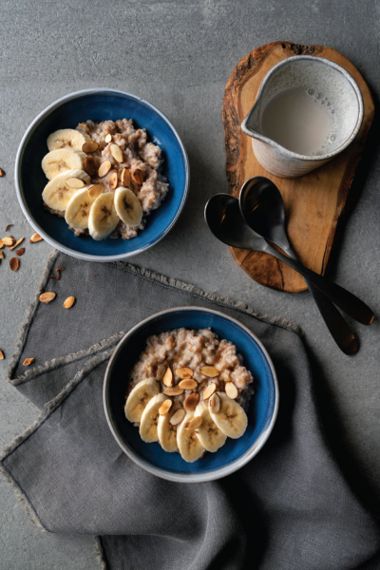
Look for whole grain farro, which leaves the germ and bran intact, for this satisfying porridge that’s sure to kickstart your day. While the cooking time is longer than for pearled or semi-pearled varieties, you’ll get more nutrition. Take the time to enjoy the delicate scent of cardamom and ginger wafting through your kitchen as you prepare this.
Ancient grain
Farro (also referred to as emmer or einkorn) is a variety of wheat known as an ancient grain, which means that it hasn’t changed over time through breeding as is the case with many varieties of modern wheat.
Cardamom and Ginger Scented Farro Breakfast Porridge
Ingredients
- 3 green dried cardamom pods
- 3 slices of fresh peeled gingerroot, about 1 inch (2.5 cm) long, 1/8 inch (0.3 cm) thick
- 1/2 cup (125 mL) farro, uncooked, rinsed
- 1 1/2 cups (350 mL) water
- 1/8 tsp (0.5 mL) salt
- 1/2 cup (125 mL) unsweetened almond milk
- 1 banana, peeled
- 2 tsp (10 mL) raw sliced almonds, toasted
- 1 tsp (5 mL) pure maple syrup (optional)
- 1/2 tsp (5 mL) additional warm spice and fruit of choice for extra flavour (optional)
Nutrition
Per serving:
- calories193
- protein5 g
- total fat3 g
- sat. fat0 g
- total carbohydrates37 g
- sugars7 g
- fibre7 g
- sodium199 mg
Directions
01
Under the blade of a heavy knife, press cardamom pods until they’re cracked but not crushed. Add to saucepan along with ginger, farro, water, and salt. Cover and bring to a boil, then reduce heat and simmer until farro is cooked but retains a nutty bite, about 40 to 50 minutes. Turn off heat and add almond milk. Stir through. Take about 1/2 cup (125 mL) of the mixture and blend in a high-powered blender or food processor to break it up somewhat. Return blended portion to farro in the pot and simmer gently for a further 5 to 10 minutes. Discard cardamom pods and ginger.
02
To serve, pour into 2 bowls. Slice banana and divide slices between the bowls. Sprinkle 1 tsp (5mL) sliced almonds overtop each bowl and drizzle with 1/2 tsp (5mL) maple syrup (if desired).





